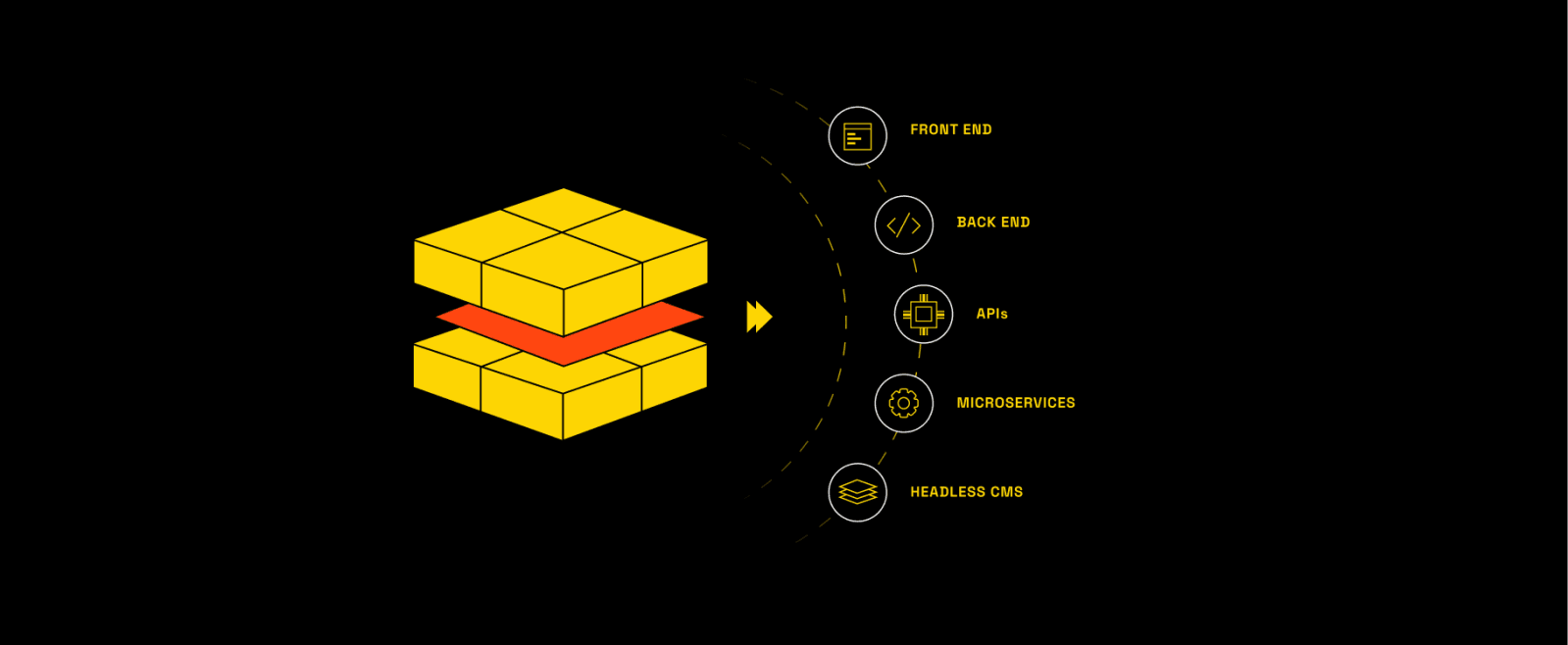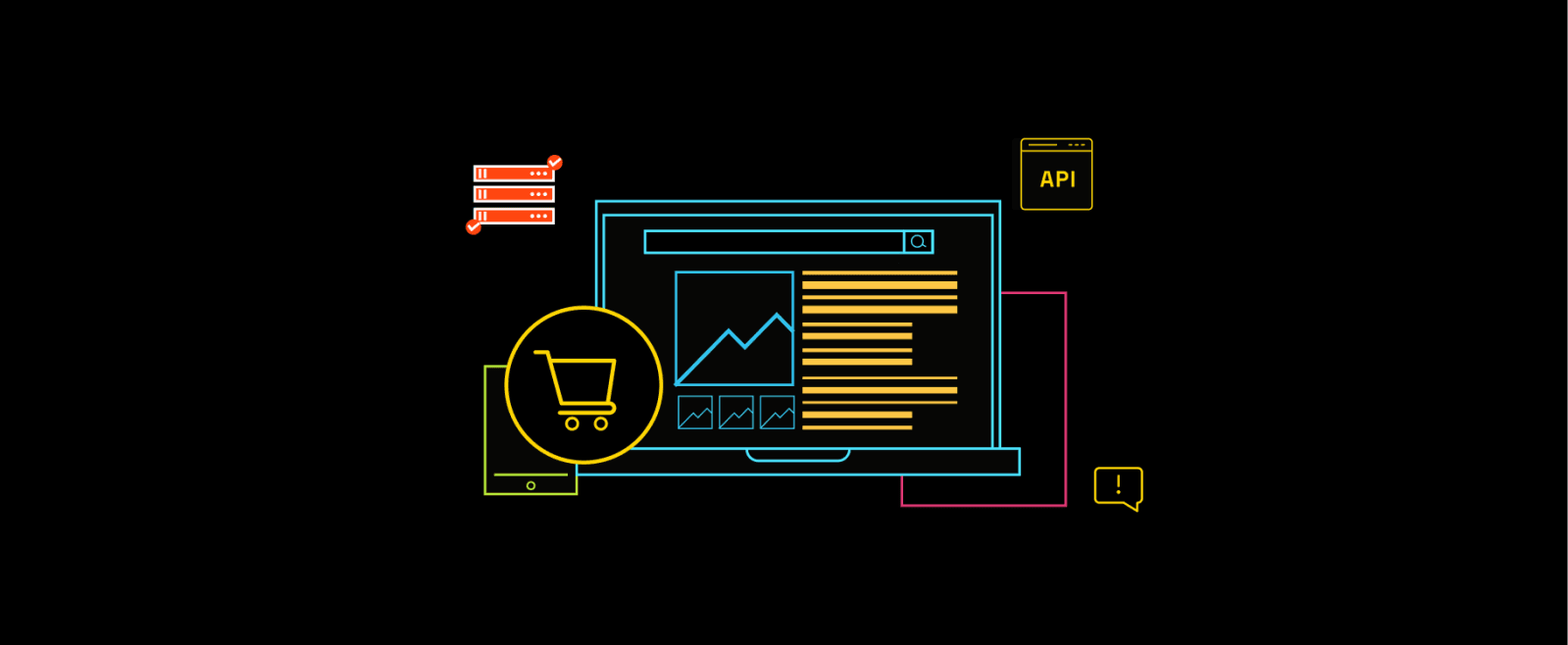Composable Commerce Cheat Sheet (2025): A Quick Decision Framework for Digital Leaders
Composable commerce is no longer optional for brands chasing agility, faster rollouts, or global scaling. But making the leap means aligning your architecture with business priorities — not just tech trends.
This quick-reference Composable Commerce cheat sheet is built for digital decision-makers who need:
-
A clear mental model of composable commerce and its business value
-
A tactical comparison of composable vs MACH
-
Implementation paths based on risk, team capability, and system maturity
-
Key metrics, ROI levers, and red flags to avoid
Whether you're mapping a 12-month replatforming strategy or proving value to stakeholders, this guide will help you translate tech architecture into business outcomes.
Who Is This Composable Commerce Cheat Sheet For?
Built for senior commerce leaders — Directors of Commerce, Heads of Digital, and Platform Architects— this cheat sheet supports teams actively evaluating composable adoption.
You'll find it beneficial if you’re:
-
Planning a phased replatform or full commerce stack overhaul
-
Preparing for global expansion, omnichannel rollout, or new market entry
-
Evaluating partner ecosystems or replacing legacy vendor lock-in
-
Seeking faster time-to-market and team autonomy through modular builds
What Is Composable Commerce? An Overview
Composable commerce offers a modular approach to digital commerce, where platforms are built by integrating best-of-breed components. It's akin to selecting ingredients for a recipe rather than purchasing a pre-packaged meal.
At the heart of composable commerce are Product Business Capabilities (PBCs) - packaged components handling specific functions like search, checkout, or inventory management. Each PBC functions independently but integrates seamlessly with others through APIs. For a deeper breakdown of how modular systems and PBCs work together in real-world implementations, explore our Composable Commerce Architecture Guide.
Composable commerce is like building a custom home: you choose the layout, the fixtures, the systems — all tailored to your needs. Traditional SaaS platforms? They’re pre-fab apartments — fixed layouts, little room to adapt.
Frameworks like Next.js make headless frontends more agile — a key piece in a composable stack — but front-end flexibility is just one layer of the full system.
Core Components of Composable Commerce (Simplified)
At its core, composable commerce is made possible by a few technical principles that enable modularity without chaos:
-
A modular architecture where each component (PBC) operates independently
-
API-first design enabling seamless integration between components
-
Cloud-native infrastructure for scalability and flexibility
-
Packaged business capabilities that can be swapped or upgraded individually
How It Compares to Traditional Platforms
| Aspect | Composable Commerce | Traditional Platforms |
|---|---|---|
| Flexibility | Choose and replace individual components as needed | Locked into vendor's full suite |
| Updates | Update specific components independently | Full platform updates required |
| Integration | Native API connectivity with any service | Limited to vendor-approved integrations |
| Innovation | Adopt new technologies as they emerge | Wait for vendor platform updates |
The main advantage of composable commerce is its adaptability to business needs, unlike traditional platforms that can limit you to a specific vendor's features and upgrade timelines. Learn more about how composable compares to MACH and headless models in our architecture comparison guide.
Why Composable Commerce Makes Business Sense (in 2025)
Digital commerce leaders are increasingly choosing composable commerce for its distinct benefits in speed, flexibility, and market responsiveness. While only 29% of enterprise retailers were still operating on traditional full-stack platforms as of IDC’s 2023 Global Retail Survey, the momentum has since accelerated.
At the time, 91% of enterprises were already planning to shift to a headless approach, blending full stack backends with composable frontends. Among the 45% that had already adopted a composable frontend, 74% were progressing toward fully modular, headless architectures — a trend that has only intensified heading into 2025.
You're Ready for Composable If...
-
Your current platform takes weeks or months to launch new features
-
You're struggling to maintain consistent experiences across markets
-
Your teams face delays due to dependencies on other departments
-
You need to quickly test and iterate on customer experiences
-
You're planning expansion into new markets or channels
-
Your technology costs rise disproportionately with growth
Where Composable Creates Advantage
Here’s where composable architecture outperforms traditional platforms:
Speed to Market
-
Launch new features within days instead of months
-
Test market-specific solutions without overhauling core systems
-
Deploy updates independently across regions
Operational Efficiency
-
Empower teams to operate in parallel without obstructions
-
Reduce maintenance costs with smaller, focused updates
-
Scale individual components based on actual needs
Business Agility
-
Replace underperforming solutions without major platform changes
-
Quickly adapt to market opportunities or threats
-
Seamlessly integrate new technologies like AI or social commerce
Avoid Composable If...
Composable isn’t always the right fit—at least not right now. If your team is in one of the following situations, revisit once foundational gaps are resolved:
-
Your business operates in a stable market with minimal changes
-
You lack internal technical skills or partner support
-
Your current platform fully meets your needs after recent investments
-
You need an immediate solution with minimal setup time
[Note: Most organizations who delay adoption do so to build internal readiness—not because the model lacks long-term value.]
Success requires aligning your business goals with composable capabilities. Although initial costs may exceed those of traditional platforms, companies seeking growth, market expansion, or digital transformation find long-term value in composable architecture through flexibility and reduced ownership costs.
Composable vs MACH Architecture: What’s the Real Difference?
MACH is often misunderstood as synonymous with composable commerce — but they’re not the same. MACH (Microservices, API-first, Cloud-native, Headless) is a technical blueprint, while composable commerce is a business strategy built atop that foundation. Think of MACH as the engineering stack, and composable as the tailored solution that delivers business outcomes.
→ Want a deeper dive into MACH? Read: What is MACH Architecture?
MACH as an Enabler (Not a Goal)
MACH's technical principles pave the way for composable opportunities by providing:
- API-first connectivity for seamless component integration
- Microservices architecture for modular functionality
- Cloud-native deployment for scalability
- Headless architecture for front-end flexibility, which you can learn more about in Why Headless Commerce is a Game Changer.
Composable = MACH + Business Fit
Composable commerce builds on MACH's foundation by adding:
- Strategic component selection based on business needs
- Orchestration of services across your ecosystem
- Business-driven integration patterns
- Operational governance and team alignment
Here’s how Composable and MACH differ across architecture, implementation, and business value:
| Aspect | MACH Architecture | Composable Commerce |
|---|---|---|
| Primary Focus | Technical architecture | Business outcomes |
| Scope | System design principles | Full commerce strategy |
| Implementation | Requires deep technical expertise | Requires business + technical collaboration |
| Value Driver | Infrastructure agility | Business adaptability and innovation |
| Integration Model | Service-level independence and decoupling | Business-driven orchestration of modular components |
| Risk Areas | Overengineering, tech sprawl | Governance gaps, integration complexity |
MACH capabilities matter — but they don’t define your business model. Let your commercial goals guide the architecture, not the other way around. A MACH foundation without orchestration, governance, or alignment to business value is just technical debt waiting to happen.
Composable Implementation Strategy: Choosing the Right Migration Path
Your migration strategy can determine the success of your composable commerce transition. If you're pondering how to start with composable commerce, here's how to select and implement the right strategy for your organization.
When to Start (Signals & Timing)
No two migrations look alike — but there are early signals that indicate your team is ready to begin replatforming. Here’s what to look for:
Signals You’re Ready for Composable:
- Your legacy system struggles to meet business goals
- Maintenance costs are becoming unsustainable
- Customer experience is declining
- Your team has fundamental knowledge of API-first architecture
Your choice between phased and big bang depends on several factors:
-
System Modularity: If your current platform can break down into services, phased migration offers lower risk. If it's a tightly integrated system, big bang may be unavoidable.
-
Team Capability: Microservices expertise and robust resources support either approach. Limited experience strongly suggests a phased implementation.
-
Risk Tolerance: Prefer lower risk? Opt for phased migration. Need rapid change and can handle disruption? Big bang might suit you.
We also did a deep dive into the Composable Commerce Migration – you can read it here.
Quick Wins to Launch With
Start with these initial steps:
- Begin with high-impact, low-risk components like product catalogs or checkout
- Implement MVPs to validate new capabilities
- Focus on components that clearly demonstrate ROI
- Build internal confidence through small successes
Decision Flow:
| Condition | Recommended Approach |
|---|---|
| Modular legacy system + skilled team | Phased Migration |
| Monolithic platform + urgent needs | Big Bang Migration |
| Limited resources + high complexity | Always Phased |
| High risk tolerance + strong technical team | Either Approach |
When to Pause or Reassess
Watch for these warning signs:
- Unresolved technical issues affecting data integrity
- Emerging team resource gaps or skill deficits
- Major shifts in business priorities
- Poor user adoption in initial rollouts
- Testing feedback unveiling fundamental flaws
Migrations don’t fail because of tech — they fail due to misalignment, unclear goals, and lack of readiness. If timelines start slipping or confidence erodes, pause early. Reset alignment across teams before costs compound.
How to Evaluate Composable Commerce Partners (Checklist Included)
Essential Evaluation Criteria
| Evaluation Area | What to Look For |
|---|---|
| Architecture Fit | API-first design, MACH compliance, modular past projects, microservices documentation |
| Implementation Track | 3+ composable builds, case studies, integration proof, industry-specific references |
| Ecosystem Strength | Pre-built integrations, vendor partnerships, open-source contributions, accelerators |
| Technical Capability | Cloud infra, API dev, performance tuning, 24/7 support, versioning governance |
Critical Questions to Ask
When shortlisting vendors or conducting RFIs, these questions help surface true composable expertise:
-
"Show us your experience with component swapping in previous projects while avoiding system disruption."
-
"What is your approach for maintaining loose coupling between services while ensuring business process integrity?"
-
"Walk us through your API versioning strategy and how you handle breaking changes."
-
"Demonstrate your experience with our existing tech stack components."
You’re looking for vendors who can confidently answer these — not dodge them with vague slides.
Alignment Indicators
Green Flags: Signs of Strong Composable Partner
-
Shares real-world lessons from failed and successful implementations
-
Provides detailed documentation of past composable builds
-
Defines clear responsibility boundaries across teams
-
Demonstrates patterns for orchestrating multi-vendor ecosystems
-
Has experience decoupling legacy systems in live environments
Red Flags: Watch Out if they...
-
Push proprietary platforms that limit vendor flexibility
-
Avoid sharing technical documentation or past architecture diagrams
-
Over-emphasize end-to-end suites rather than modular solutions
-
Lack hands-on experience with API-first and MACH principles
-
Struggle to explain integration strategies or versioning policies
These indicators help cut through the hype. Ask for specifics, not just slide decks — the right partner should guide you through tradeoffs, not just agree with your team.
Composable Commerce Performance Metrics: A Cheatsheet for 2025
Comprehending composable commerce ROI metrics is paramount for stakeholders interested in financial impacts and performance.
Short-Term Wins
These are the leading KPIs organizations use to validate value in the first 3–6 months:
| Metric | What It Indicates |
|---|---|
| Deployment frequency | DevOps agility and release velocity |
| System uptime | Reliability and resilience |
| API response time | System performance and customer experience |
| Integration completion time | Implementation efficiency |
| Infra cost per transaction | Operational cost efficiency |
| Time-to-market (business) | Speed of delivering value |
| Cart abandonment rate | CX improvements and funnel efficiency |
| First-time conversion rate | Customer activation success |
| Developer productivity | Internal team performance (e.g. story points) |
Long-Term Strategic Value
Composable’s full impact becomes visible over 12–24 months. These metrics signal long-term scalability, agility, and total cost advantage:
Long-Term Technical Metrics:
| Metric | What It Reflects |
|---|---|
| Total cost of ownership (TCO) | Long-term reduction in infrastructure, licensing, and ops costs |
| System scalability | Ability to handle peak loads without degradation |
| Technical debt reduction | Cleaner, more maintainable code and architecture |
| Integration velocity | Speed of connecting new tools or platforms |
| Platform stability | Resilience across distributed components and uptime consistency |
Long-term Business Metrics:
| Metric | What It Reflects |
|---|---|
| Customer lifetime value (CLTV) | Impact of personalized, modular experiences on loyalty |
| Market expansion speed | Time-to-market for new geo, product, or channel rollouts |
| Revenue per developer | Efficiency of your tech team post-composable transition |
| Innovation cycle time | How fast your team can test and launch new capabilities |
| Global market penetration | Reach enabled by flexible infrastructure and localization |
One well-known example comes from Cimpress during the early days of the pandemic. They leveraged composable commerce to rapidly pivot their product lines — launching face masks and PPE while legacy competitors lagged. Their modular architecture allowed them to:
- Launch new products in days
- Instantly scale infrastructure
- Maintain performance under pressure
- Plug in new suppliers on demand
While the circumstances were unique, the lessons in agility and modular scalability still apply in today’s enterprise commerce landscape.
Your ROI isn’t just financial — it’s architectural. Don’t just measure what’s easy to track. Measure what moves your business forward: speed, scalability, experience, and adaptability. Start with a baseline before migration and track against both technical velocity and business value over time. ROI in composable is not a dashboard — it’s a discipline.
Avoiding the 6 Most Common Composable Mistakes (and How to Fix Them)
| Common Mistake | How to Avoid It |
|---|---|
| Overengineering microservices | Start with 3–5 business-aligned domains; don’t split unless there's clear value |
| No orchestration plan | Define workflows up front and layer in orchestration tools (like API gateways) |
| Siloed tool choices | Set integration guardrails and use a formal vendor evaluation checklist |
| Business teams left out | Involve operations leads in architecture decisions from the beginning |
| Vendor mismatch | Vet partners for MACH compliance + real integration history |
| Ignoring long-term maintenance | Plan for cost, versioning, monitoring, and governance from Day 1 |
Want to see how we structure domain-based rollouts and orchestration layers in live implementations? [Talk to our engineering team, drop a line at hello@coderapper.com]
Composable Commerce: Proven Patterns, Playbooks, and Mistakes to Avoid
Do's and Don'ts
| ✅ Do This | ❌ Don't Do This |
|---|---|
| Start with clear business requirements and KPIs | Rush into implementation without stakeholder alignment |
| Build strong cross-functional collaboration | Work in silos or ignore business teams |
| Develop a comprehensive data strategy | Underestimate integration complexity |
| Prioritize customer experience | Lock into vendors without confirming fit |
| Plan for scalability from the beginning | Skip the MVP testing phase |
| Uphold modular architecture principles | Override standards for speed |
Playbook 1: Phased MVP Launch
For teams prioritizing speed-to-value with gradual rollout.
Phase 1: Core Commerce Foundation
- Launch minimal storefronts
- Implement basic order management
- Set up primary integrations
Phase 2: Experience Enhancement
- Add personalization layers
- Expand channel capabilities
- Integrate advanced features
Phase 3: Scale and Optimize
- Implement advanced analytics
- Add market-specific customizations
- Optimize performance metrics
Playbook 2: Domain-Driven Implementation
For orgs with clear business process ownership and long-term scaling goals.
Step 1: Domain Mapping
- Map business domains (orders, inventory, customers)
- Identify domain owners
- Set domain-specific KPIs
Step 2: Prioritized Rollout
- Start with the highest-impact domain
- Build foundational services
- Validate domain interactions
Step 3: Continuous Evolution
- Measure domain performance
- Iterate based on metrics
- Scale successful patterns
Not every team needs a domain-driven rollout on Day 1. Not every MVP launches scales. Choose the playbook that reflects your team’s capabilities, governance maturity, and commercial urgency.
These patterns aren’t theoretical. They’re distilled from real replatforming journeys across B2B, B2C, and enterprise retail.
If you're evaluating composable — and want help defining your rollout strategy, governance model, or migration scope — book a strategy consult with our team. Drop us a line at hello@coderapper.com.






